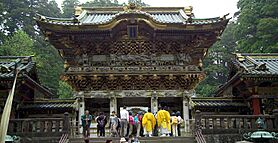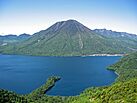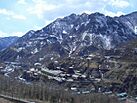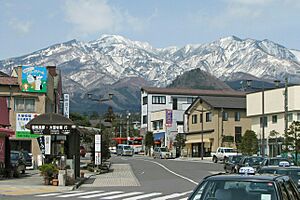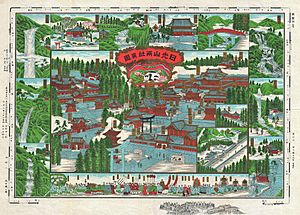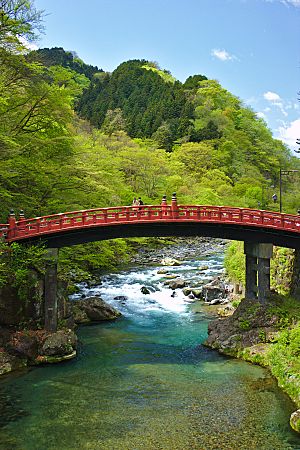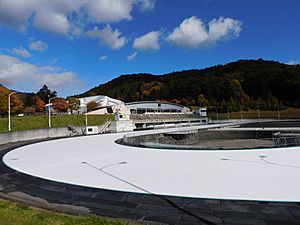Nikkō facts for kids
Quick facts for kids
Nikkō
日光市
|
|||||||||||||
|---|---|---|---|---|---|---|---|---|---|---|---|---|---|
|
From top, left to right: Nikkō Tōshō-gū, Kegon Falls, Kinugawa Onsen, Lake Chūzenji and Mount Nantai, and Ashio Copper Mine
|
|||||||||||||
|
|||||||||||||
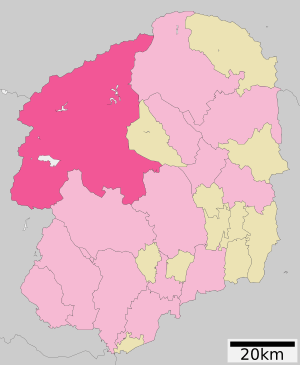
The location of Nikkō in Tochigi Prefecture
|
|||||||||||||
| Country | Japan | ||||||||||||
| Region | Kantō | ||||||||||||
| Prefecture | Tochigi | ||||||||||||
| First official recorded | 766 AD | ||||||||||||
| City Settled | February 11, 1954 | ||||||||||||
| Area | |||||||||||||
| • Total | 1,449.83 km2 (559.78 sq mi) | ||||||||||||
| Population
(October 1, 2021)
|
|||||||||||||
| • Total | 76,452 | ||||||||||||
| • Density | 52.7317/km2 (136.5745/sq mi) | ||||||||||||
| Time zone | UTC+9 (Japan Standard Time) | ||||||||||||
| Phone number | 0288-22-1111 | ||||||||||||
| Address | 1 Imaichi Honchō, Nikkō-shi, Tochigi-ken 321–1292 | ||||||||||||
| Climate | Dfb | ||||||||||||
|
|||||||||||||
Nikkō (日光市, Nikkō-shi, IPA: [ɲikkoꜜːɕi]) is a beautiful city in Tochigi Prefecture, Japan. It's a very popular place for both Japanese and international tourists. As of December 2, 2020, about 80,239 people lived there.
Nikkō is famous for its amazing attractions. You can visit the mausoleum (a special tomb) of the shōgun Tokugawa Ieyasu at the Nikkō Tōshō-gū shrine. His grandson Iemitsu also has a mausoleum nearby. The Futarasan Shrine is also very old, dating back to 767 AD. The area is also known for its many relaxing hot springs, called onsen.
Nikkō is located at different heights, from 200 to 2,000 meters above sea level. There's a famous Japanese saying: "Never say kekkō until you've seen Nikkō." Kekkō means splendid or magnificent. This saying shows just how beautiful and wonderful Nikkō is!
Contents
Exploring Nikkō's Geography
Nikkō is a very large city by area, covering about 1,449.83 square kilometers. It's in the rural northwestern part of Tochigi Prefecture. Nikkō is about 140 kilometers north of Tokyo and 35 kilometers west of Utsunomiya, which is the capital of Tochigi. It's actually the third-largest city in Japan by land area!
Two important rivers, the Watarase River and the Kinugawa River, flow through Nikkō. You can also find Lake Chūzenji and the stunning Kegon Falls here. The Nikko Botanical Garden is another lovely spot. Because of its many mountains and waterfalls, Nikkō is a big source of hydroelectric power, which is electricity made from water. The area has also been used for mining copper.
Nikkō's Climate and Weather
The weather in Nikkō is quite unique. Even though it's much closer to Tokyo, its climate is similar to Hokkaidō, Japan's northern island. This is because Nikkō is high up in the mountains. The higher you go, the cooler it gets.
The average temperature in Nikkō is around 7°C (44°F). In the warmest months, it reaches about 22°C (72°F). In the coldest months, temperatures can drop to about −8°C (17°F). Nikkō has warm summers and cold winters with a lot of snow. The wettest month is usually September.
| Climate data for Nikkō (1991−2020 normals, extremes 1944−present) | |||||||||||||
|---|---|---|---|---|---|---|---|---|---|---|---|---|---|
| Month | Jan | Feb | Mar | Apr | May | Jun | Jul | Aug | Sep | Oct | Nov | Dec | Year |
| Record high °C (°F) | 12.7 (54.9) |
14.0 (57.2) |
16.7 (62.1) |
23.2 (73.8) |
26.4 (79.5) |
26.8 (80.2) |
30.4 (86.7) |
30.8 (87.4) |
28.4 (83.1) |
25.3 (77.5) |
19.1 (66.4) |
17.2 (63.0) |
30.8 (87.4) |
| Mean daily maximum °C (°F) | −0.3 (31.5) |
0.6 (33.1) |
4.2 (39.6) |
10.1 (50.2) |
15.3 (59.5) |
18.0 (64.4) |
22.1 (71.8) |
22.9 (73.2) |
18.9 (66.0) |
13.7 (56.7) |
8.6 (47.5) |
2.8 (37.0) |
11.4 (52.5) |
| Daily mean °C (°F) | −3.9 (25.0) |
−3.5 (25.7) |
−0.3 (31.5) |
5.1 (41.2) |
10.3 (50.5) |
14.0 (57.2) |
18.2 (64.8) |
18.8 (65.8) |
15.2 (59.4) |
9.6 (49.3) |
4.4 (39.9) |
−1.0 (30.2) |
7.2 (45.0) |
| Mean daily minimum °C (°F) | −7.9 (17.8) |
−7.8 (18.0) |
−4.6 (23.7) |
0.2 (32.4) |
5.5 (41.9) |
10.4 (50.7) |
14.9 (58.8) |
15.6 (60.1) |
11.9 (53.4) |
5.7 (42.3) |
0.2 (32.4) |
−4.9 (23.2) |
3.3 (37.9) |
| Record low °C (°F) | −16.5 (2.3) |
−16.7 (1.9) |
−18.7 (−1.7) |
−11.0 (12.2) |
−5.4 (22.3) |
−0.4 (31.3) |
3.7 (38.7) |
6.0 (42.8) |
−0.2 (31.6) |
−3.9 (25.0) |
−9.7 (14.5) |
−14.7 (5.5) |
−18.7 (−1.7) |
| Average precipitation mm (inches) | 57.5 (2.26) |
48.6 (1.91) |
108.5 (4.27) |
154.4 (6.08) |
177.1 (6.97) |
228.8 (9.01) |
280.5 (11.04) |
332.5 (13.09) |
409.0 (16.10) |
240.9 (9.48) |
97.6 (3.84) |
58.4 (2.30) |
2,202 (86.69) |
| Average snowfall cm (inches) | 63 (25) |
56 (22) |
57 (22) |
13 (5.1) |
0 (0) |
0 (0) |
0 (0) |
0 (0) |
0 (0) |
0 (0) |
3 (1.2) |
33 (13) |
227 (89) |
| Average precipitation days (≥ 1.0 mm) | 6.4 | 6.6 | 9.5 | 10.7 | 11.3 | 14.3 | 16.4 | 15.3 | 14.4 | 11.1 | 6.7 | 6.2 | 128.9 |
| Average snowy days (≥ 1 cm) | 12.9 | 12.6 | 11.0 | 2.3 | 0.1 | 0 | 0 | 0 | 0 | 0 | 0.8 | 7.2 | 46.9 |
| Average relative humidity (%) | 66 | 65 | 67 | 69 | 75 | 87 | 88 | 89 | 88 | 83 | 73 | 69 | 77 |
| Mean monthly sunshine hours | 164.6 | 167.0 | 189.5 | 187.1 | 174.1 | 107.8 | 109.6 | 128.2 | 105.1 | 122.8 | 152.1 | 153.2 | 1,763.1 |
| Source: Japan Meteorological Agency | |||||||||||||
Nikkō's Population Over Time
The number of people living in Nikkō has slowly gone down over the last 20 years.
| Historical population | ||
|---|---|---|
| Year | Pop. | ±% |
| 1950 | 107,674 | — |
| 1960 | 110,468 | +2.6% |
| 1970 | 99,415 | −10.0% |
| 1980 | 97,515 | −1.9% |
| 1990 | 97,859 | +0.4% |
| 2000 | 98,143 | +0.3% |
| 2010 | 90,064 | −8.2% |
| 2020 | 77,661 | −13.8% |
| Japanese census data | ||
A Look at Nikkō's History
The history of Nikkō began in 766 AD. That's when a monk named Shōdō Shōnin (勝道上人) founded the Rinnō-ji temple. Later, in 784, he also established the Chūzen-ji temple. A small village grew up around these important temples.
A very significant event was the completion of the Nikkō Tōshō-gū shrine in 1617. This shrine became a huge attraction for visitors during the Edo period (1603-1868). It is known as the burial place of the famous shōgun Tokugawa Ieyasu. To make it easier for people to visit, many new roads were built. Today, the Nikkō Tōshō-gū, Futarasan Shrine, and Rinnō-ji are together a UNESCO World Heritage Site called Shrines and Temples of Nikkō.
During the Meiji period (1868-1912), Nikkō became a popular mountain resort. It was especially liked by foreign visitors. Getting to Nikkō became even easier when the Japanese National Railways started train service in 1890. The Tobu Railway followed in 1929.
Nikkō officially became a town in 1889. Then, in 1954, it became a city after joining with a nearby village. In 2006, Nikkō grew even bigger by combining with several other towns and villages. This made the city of Nikkō much larger than before.
Nikkō's Economy and Jobs
Nikkō's economy mostly relies on tourism. People come to see its historic sites, beautiful scenery, and enjoy the hot spring resorts. Making hydroelectric power (electricity from water), processing food, and working with non-ferrous metals (metals like copper that don't contain iron) are also important parts of the economy.
Nikkō is also recognized for its modern technology. The Japanese government has supported Nikkō in developing good internet and computer systems for people who work from home. This helps the city grow and adapt to new ways of working.
Fun Places to Visit in Nikkō
-
True Light Anglican Church, built in 1916
- Cedar Avenue of Nikko: A long road lined with ancient cedar trees.
- Nikko Botanical Garden: A beautiful garden to explore different plants.
- Tamozawa Imperial Villa: A former imperial residence with lovely gardens.
- Shrines and Temples of Nikkō: This includes the famous Nikkō Tōshō-gū, Futarasan Shrine, and Rinnō-ji.
- At Nikkō Tōshō-gū, look for the carvings of the Three wise monkeys ("See no evil, hear no evil, speak no evil").
- Rinnō-ji: An important temple with the Taiyū-in Mausoleum and the beautiful Shōyō-en Garden.
- Lake Chūzenji: A scenic lake perfect for enjoying nature.
- Edo Wonderland Nikko Edomura: A fun historical theme park where you can experience what Japan was like during the Edo period.
- Monkeys: In winter, you might see monkeys walking around town looking for food!
- Jizō Bosatsu statues on the Kanman Walk: Locals say if you count these statues on your way there and back, you'll get a different number!
- Kanmangafuchi Abyss: A unique place formed by lava from the eruption of Mount Nantai.
Getting Around Nikkō
You can travel to and around Nikkō by train and car.
Train Travel
Several train lines serve Nikkō, connecting it to other parts of Japan.
- JR East – Nikkō Line
- Stations: Fubasami - Shimotsuke-Ōsawa - Imaichi - Nikkō
- Tōbu Railway – Tōbu Nikkō Line
- Stations: Shimo-Goshiro - Myōjin - Shimo-Imaichi - Kami-Imaichi - Tōbu Nikkō
- Tōbu Railway – Tōbu Kinugawa Line
- Stations: Shimo-Imaichi - Daiya-Mukō - Ōkuwa - Shin-Takatoku - Kosagoe - Tobu World Square - Kinugawa-Onsen - Kinugawa-Kōen - Shin-Fujiwara
- Yagan Railway
- Stations: Shin-Fujiwara - Ryūōkyō - Kawaji-Onsen - Kawaji-Yumoto - Yunishigawa-Onsen - Nakamiyori-Onsen - Kamimiyori-Shiobara-Onsenguchi - Ojika-Kōgen
- Watarase Keikoku Railway
- Stations: Haramukō - Tsūdō - Ashio - Matō
Road Travel
Major highways also connect Nikkō to other cities.
 Tōhoku Expressway
Tōhoku Expressway Nikkō Utsunomiya Road
Nikkō Utsunomiya Road National Route 119
National Route 119 National Route 120
National Route 120 National Route 121
National Route 121 National Route 122
National Route 122 National Route 352
National Route 352 National Route 400
National Route 400 National Route 461
National Route 461
Sports in Nikkō
Nikkō is home to the Nikkō Ice Bucks, a professional ice hockey team that plays in the Asia League Ice Hockey. The Nikkō Kirifuri Ice Arena has even hosted international ice hockey championships. There's also a special track for speed skating.
Learning in Nikkō: Education
Nikkō has many schools for young people. The city government runs 23 public primary schools, 12 public middle schools, and three schools that combine primary and middle levels. The Tochigi Prefectural Board of Education operates three public high schools in the city. There's also a special education school for students with disabilities.
High schools in Nikkō include:
- Tochigi Prefectural Nikko Meiho High School
- Tochigi Prefectural Imaichi High School
- Tochigi Prefectural Imaichi Technical High School
Famous People from Nikkō
- Masaru Ibuka: A very important businessman who helped start Sony, a famous electronics company.
- Shoma Sato: A professional baseball player.
- Akio Fukuda: A politician.
- Tomikazu Fukuda: A politician.
Nikkō's Sister Cities
Nikkō has special relationships with other cities around the world, called "sister cities" or "friendship cities."
 Rapid City, South Dakota, United States (since 1993)
Rapid City, South Dakota, United States (since 1993) Tainan, Taiwan (since 2009)
Tainan, Taiwan (since 2009) Odawara, Kanagawa Prefecture, Japan (since 1980)
Odawara, Kanagawa Prefecture, Japan (since 1980)
See also
 In Spanish: Nikkō (Tochigi) para niños
In Spanish: Nikkō (Tochigi) para niños


